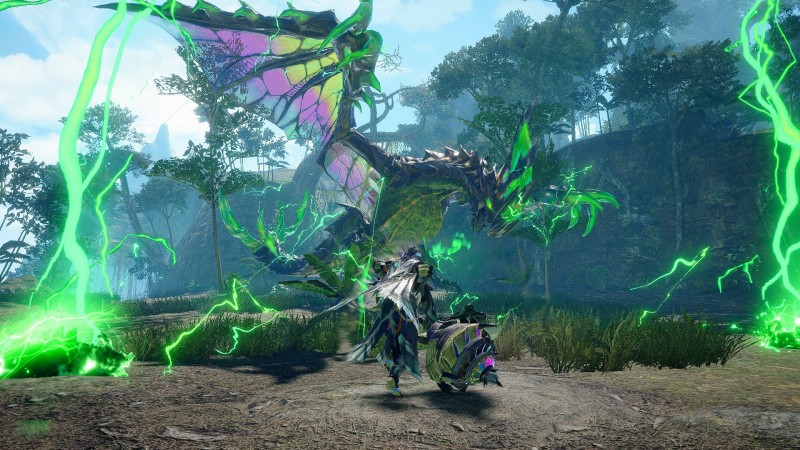Monster Hunter Rise was one of my favorite games of 2021. I’ve played dozens of hours on Switch and, in preparation for this review, I happily worked through the necessary hub quests to ensure I was ready to dive straight into Sunbreak. Capcom’s new expansion is a great time for existing hunters with fun new monsters to fight and added flexibility to its combat systems, but the slow introduction of meaningful new content means the experience is dragging into the later stages of the main campaign.
Sunbreak takes hunters across a vast body of water, away from Rise’s Japanese-centric Kamura Village and into the European-inspired Kingdom region. There, a powerful trio of monsters known as The Three Lords terrorize the land, while other creatures from this area appear in faraway regions like Kamura, prompting hunters to take on quests at the previously available Rise locations. The Elgado Outpost, the new base of operations, is small and uninteresting, leaving little to do other than the necessary loop for crafting gear and preparing for the hunt ahead. It’s just doing the bare minimum of providing handy vendors and quest givers, and while that’s all it really needs to be, I wish Capcom would pay as much attention to the environment as they did in Kamura Village.
The expansion shines with the right monster hunts. Sunbreak introduces a handful of awesome monsters to complement Rise’s original roster, but distributes them at a painfully slow pace. The big three creatures at the center of Elgado’s woes are Garangolm, Lunagaron, and the vampire-inspired flagship monster, Malzeno. They serve as gatekeepers to level up Master Rank quests, each offering a unique combat challenge and awesome new gear to craft. However, in order to challenge the first of these, I had to fight my way through a selection of monsters that I’ve defeated many times since Rise’s release.
The expansion kicks off the new Master Tier difficulty with a new creature in the game, Damiyo Hermitaur, a returning Hermit Crab monster from an earlier entry in the series. After that, the game returns to slightly more difficult versions of the same hunts available in low and high rank quests. Creatures have new moves and traits that add complexity and complexity to familiar combat. Still, these missions are well-trodden territory for seasoned Monster Hunter players. I was expecting the existing list to be used, but starting with a majority of slightly adjusted old encounters is a boring way to start an exciting expansion. With that said, more monsters arrive after hours of progression, and each one is a desperate and needed shot of variety in the list of available hunts. The Three Lords, returning favorites Astalos and Seregios, and subspecies variants like Magma Almudron are fun to take on, and rewarding fights to master.

Monster Hunter’s environment is just as important as the targets themselves. Jungle, a stage from the second generation of Monster Hunter, returns after Sunbreak. It’ll be a fantastic piece of nostalgia for many, but after a few hunts it feels small and uncomplicated compared to other locations in Rise. Another new, more important arena addition called The Citadel features all sorts of little enclaves and paths, making the region dense with traversal and pursuit options. It’s also packed with different biomes like a drab resin swamp that slows down monsters and hunters alike, a cave that shimmers with the sheen of a sheet of ice, and a crumbling castle that makes battles with Elder Dragons and other giant monsters seem even more epic. New endemic critters like puppet spiders can trip up monsters, and insects that affect wyvern riding are scattered across maps, introducing fun new strategies for dealing with monsters on the hunt.
Increasing the difficulty to master rank will obviously make things harder for players, but each iteration of Monster Hunter also brings the necessary quality of life changes. Switch Skill Swap provides a way to change your weapon-specific attacks on the fly in battle. You can equip two loadouts with five moves and switch between the two maneuvers whenever you need to by pressing a series of buttons. I would use my most trusted Hammer skills on top of my main Switch skills, and if I need a specific Silkbind attack to quickly engage a monster, I can swap them out to take advantage of my extra move kit. I love the flexibility Switch Skill Swap offers and the agency it gives players to mold a preferred playstyle into the typically rigid weapon archetypes.
There’s even more quest variety with the new single player Chaser Quests, which allow me to take the various characters around Elgado Outpost and Kamura Village on a hunt. Guest hunters like Lady Fiorayne and Admiral Galleus have special weapon specialties and can join the hunters on these quests. I was hoping that these missions would bring a new narrative twist to Monster Hunter, but aside from having an NPC fight by my side and occasionally quip, Follower Quests play out like any other average hunt. However, they help in learning how to take on new monsters and often act as a training mission, rewarding monster materials to craft gear for tougher solo tasks.
Overall I had a great time with Sunbreak. The lack of new monsters plagues the wee hours, but there’s a lot to love if you keep at it. The added flexibility of the Switch Skill Swap system is a liberating and fun addition to combat for hardcore hunters, and the new creatures in the Master Rank quests – if you can achieve them – breathe life into the experience. For someone who has already invested in Monster Hunter, there is much to love in Sunbreak. Just don’t expect to see a lot of new content during opening hours.








